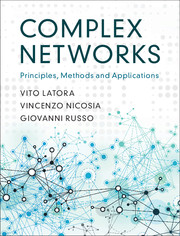Book contents
- Frontmatter
- Dedication
- Contents
- Preface
- Introduction
- Epigraph
- 1 Graphs and Graph Theory
- 2 Centrality Measures
- 3 Random Graphs
- 4 Small-World Networks
- 5 Generalised Random Graphs
- 6 Models of Growing Graphs
- 7 Degree Correlations
- 8 Cycles and Motifs
- 9 Community Structure
- 10 Weighted Networks
- Appendices
- References
- Author Index
- Index
Introduction
Published online by Cambridge University Press: 11 October 2017
- Frontmatter
- Dedication
- Contents
- Preface
- Introduction
- Epigraph
- 1 Graphs and Graph Theory
- 2 Centrality Measures
- 3 Random Graphs
- 4 Small-World Networks
- 5 Generalised Random Graphs
- 6 Models of Growing Graphs
- 7 Degree Correlations
- 8 Cycles and Motifs
- 9 Community Structure
- 10 Weighted Networks
- Appendices
- References
- Author Index
- Index
Summary
The Backbone of a Complex System
Imagine you are invited to a party; you observe what happens in the room when the other guests arrive. They start to talk in small groups, usually of two people, then the groups grow in size, they split, merge again, change shape. Some of the people move from one group to another. Some of them know each other already, while others are introduced by mutual friends at the party. Suppose you are also able to track all of the guests and their movements in space; their head and body gestures, the content of their discussions. Each person is different from the others. Some are more lively and act as the centre of the social gathering: they tell good stories, attract the attention of the others and lead the group conversation. Other individuals are more shy: they stay in smaller groups and prefer to listen to the others. It is also interesting to notice how different genders and ages vary between groups. For instance, there may be groups which are mostly male, others which are mostly female, and groups with a similar proportion of both men and women. The topic of each discussion might even depend on the group composition. Then, when food and beverages arrive, the people move towards the main table. They organise into more or less regular queues, so that the shape of the newly formed groups is different. The individuals rearrange again into new groups sitting at the various tables. Old friends, but also those who have just met at the party, will tend to sit at the same tables. Then, discussions will start again during the dinner, on the same topics as before, or on some new topics. After dinner, when the music begins, we again observe a change in the shape and size of the groups, with the formation of couples and the emergence of collective motion as everybody starts to dance.
The social system we have just considered is a typical example of what is known today as a complex system [16, 44]. The study of complex systems is a new science, and so a commonly accepted formal definition of a complex system is still missing.
Information
- Type
- Chapter
- Information
- Complex NetworksPrinciples, Methods and Applications, pp. xii - xxiiPublisher: Cambridge University PressPrint publication year: 2017
